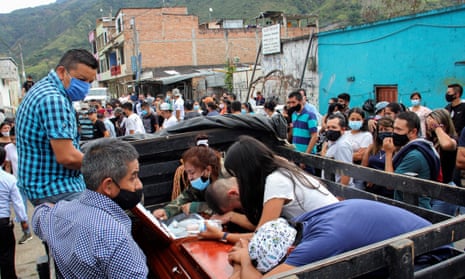A provincial governor in southern Colombia has warned that the region is “in a state of anarchy – complete disorder” amid a fresh wave of violence that has claimed at least 13 lives in the past week.
Jhon Alexánder Rojas, the governor of the Nariño province, sounded the alarm in an interview with the newspaper El Espectador, after eight people – all aged between 17 and 26 – were killed in a massacre at a barbecue in the small town of Samaniego on Saturday night.
“This is what happens here, in any moment one can run into illegal armed groups who’ll kill anyone without saying a word,” said Rojas. “There’s nothing we can de except hope to God that this stops.”
Authorities have yet to identify the masked attackers with rifles. Nariño, which sits on Colombia’s southern border with Ecuador, is rife with coca crops, the key ingredient used to make cocaine, and plagued by armed groups.
A 2016 peace deal with the country’s largest rebel group, the Revolutionary Armed Forces of Colombia (Farc), formally ended five decades of civil war that killed over 260,000 people and displaced 7 million.
The accord was supposed to bring with it increased security and development in to Colombia’s poorest regions – such as Nariño – but such change has been elusive, with dissident Farc factions fighting for territorial control with a rival leftist guerrilla group, the National Liberation Army, ELN, rightwing paramilitary groups, drug cartels and the Colombian military.
Colombia has seen 33 massacres this year, according to the United Nations’ peace mission in the country, which said on Monday that 45 human rights defenders have been killed in the same period.
Rojas, the governor, called on the government of President Iván Duque – a skeptic of the peace deal – to dialog with armed groups in the region and to implement the accord.
The massacre on Saturday night followed two other killings in the province in the past seven days that left at least four others dead.
Five Afro-Colombian teenagers were found brutally tortured and murdered in Cali, the capital of the neighbouring Valle del Cauca province, on Tuesday, triggering outcry from human rights groups.
“Given Duque’s unwillingness to truly advance the implementation of the peace process and refusal to make peace with the ELN it is not surprising that we are seeing a resurgence of massacres in Colombia,” said Gimena Sánchez, Andes director at the Washington Office on Latin America, a thinktank. “Rather than taking advantage of the opportunity to dismantle illegal groups and strengthen justice, Duque is reverting to security policies that don’t work.”
